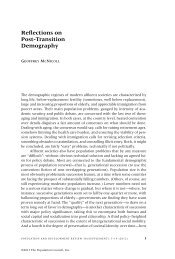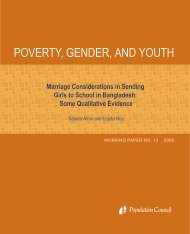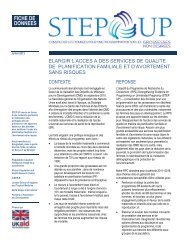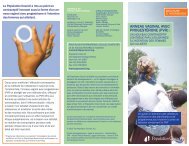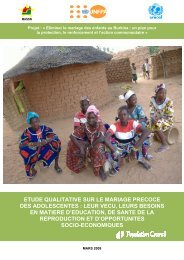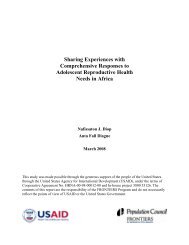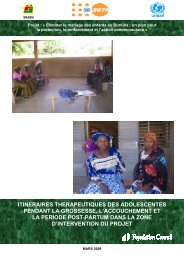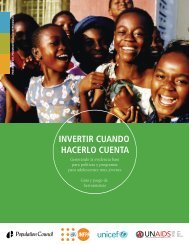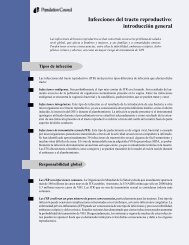- Page 1 and 2:
USAID UNITED STATES AGENCY I N T E
- Page 3 and 4:
© 2009 The Population Council, Inc
- Page 5 and 6:
Preface iv The Community-based Heal
- Page 7 and 8:
Acknowledgements vi The Ministry of
- Page 9 and 10:
viii MDGs Millennium development go
- Page 11 and 12:
x Module 4 The work of Community He
- Page 13 and 14:
Module 1 The CHPS Concept Module Ov
- Page 15 and 16:
Module 1 The CHPS Concept Topic 1 T
- Page 17 and 18:
Module 1 The CHPS Concept 6 Low fam
- Page 19 and 20:
Module 1 The CHPS Concept 8 Figure
- Page 21 and 22:
Module 1 The CHPS Concept 10 Milest
- Page 23 and 24:
Module 1 The CHPS Concept 12 Figure
- Page 25 and 26:
Module 1 The CHPS Concept 14 Figure
- Page 27 and 28:
Module 1 The CHPS Concept 16 Exerci
- Page 29 and 30:
Module 1 The CHPS Concept Topic 3 R
- Page 31 and 32:
Module 1 The CHPS Concept 20 Box 1.
- Page 33 and 34:
Module 1 The CHPS Concept 22 Benefi
- Page 35 and 36:
Module 1 The CHPS Concept 24 The se
- Page 37 and 38:
Module 1 The CHPS Concept Unit 2 Co
- Page 39 and 40:
Module 1 The CHPS Concept 28 Exerci
- Page 41 and 42:
Module 1 The CHPS Concept 30 Exerci
- Page 43 and 44:
Module 1 The CHPS Concept 32 common
- Page 45 and 46:
Module 1 The CHPS Concept 34 Box 1.
- Page 47 and 48:
Module 1 The CHPS Concept 36 Unit S
- Page 49 and 50:
Module 1 The CHPS Concept 38 groups
- Page 51 and 52:
Module 1 The CHPS Concept 40 Volunt
- Page 53 and 54:
Module 1 The CHPS Concept Topic 3 I
- Page 55 and 56:
Module 1 The CHPS Concept 44 Seeing
- Page 57 and 58:
Module 1 The CHPS Concept 46 Box 1.
- Page 59 and 60:
Module 1 The CHPS Concept 48 Tellin
- Page 61 and 62:
Module 1 The CHPS Concept 50 Keepin
- Page 63 and 64:
Module 1 The CHPS Concept 52 Figure
- Page 65 and 66:
Module 1 The CHPS Concept Unit 4 Te
- Page 67 and 68:
Module 1 The CHPS Concept 56 What d
- Page 69 and 70:
Module 1 The CHPS Concept 58 2. 3.
- Page 71 and 72: Module 1 The CHPS Concept 60 Exerci
- Page 73 and 74: Module 1 The CHPS Concept 62 Exerci
- Page 75 and 76: Module 1 The CHPS Concept 64 Box 1.
- Page 77 and 78: Module 1 The CHPS Concept 66 The le
- Page 79 and 80: Module 1 The CHPS Concept Topic 1 D
- Page 81 and 82: Module 1 The CHPS Concept Topic 2 S
- Page 83 and 84: Module 1 The CHPS Concept 72 Power
- Page 85 and 86: Module 1 The CHPS Concept 74 themse
- Page 87 and 88: Module 1 The CHPS Concept Topic 3 P
- Page 89 and 90: Module 1 The CHPS Concept 78 Being
- Page 91 and 92: Module 1 The CHPS Concept 80 ALWAYS
- Page 93 and 94: Module 1 The CHPS Concept 82 Do tho
- Page 95 and 96: Module 1 The CHPS Concept Module Su
- Page 97 and 98: Module 1 The CHPS Concept 86 Experi
- Page 99 and 100: Module 1 The CHPS Concept 88
- Page 101 and 102: Module 2 Community Mobilisation and
- Page 103 and 104: Module 2 Community Mobilisation and
- Page 105 and 106: Module 2 Community Mobilisation and
- Page 107 and 108: Module 2 Community Mobilisation and
- Page 109 and 110: Module 2 Community Mobilisation and
- Page 111 and 112: Module 2 Community Mobilisation and
- Page 113 and 114: Module 2 Community Mobilisation and
- Page 115 and 116: Module 2 Community Mobilisation and
- Page 117 and 118: Module 2 Community Mobilisation and
- Page 119 and 120: Module 2 Community Mobilisation and
- Page 121: Module 2 Community Mobilisation and
- Page 125 and 126: Module 2 Community Mobilisation and
- Page 127 and 128: Module 2 Community Mobilisation and
- Page 129 and 130: Module 2 Community Mobilisation and
- Page 131 and 132: Module 2 Community Mobilisation and
- Page 133 and 134: Module 2 Community Mobilisation and
- Page 135 and 136: Module 2 Community Mobilisation and
- Page 137 and 138: Module 2 Community Mobilisation and
- Page 139 and 140: Module 2 Community Mobilisation and
- Page 141 and 142: Module 2 Community Mobilisation and
- Page 143 and 144: Module 2 Community Mobilisation and
- Page 145 and 146: Module 2 Community Mobilisation and
- Page 147 and 148: Module 2 Community Mobilisation and
- Page 149 and 150: Module 2 Community Mobilisation and
- Page 151 and 152: Module 2 Community Mobilisation and
- Page 153 and 154: Module 2 Community Mobilisation and
- Page 155 and 156: Module 2 Community Mobilisation and
- Page 157 and 158: Module 2 Community Mobilisation and
- Page 159 and 160: Module 2 Community Mobilisation and
- Page 161 and 162: Module 3 The Work of the Health Com
- Page 163 and 164: Module 3 The Work of the Health Com
- Page 165 and 166: Module 3 The Work of the Health Com
- Page 167 and 168: Module 3 The Work of the Health Com
- Page 169 and 170: Module 3 The Work of the Health Com
- Page 171 and 172: Module 3 The Work of the Health Com
- Page 173 and 174:
Module 3 The Work of the Health Com
- Page 175 and 176:
Module 3 The Work of the Health Com
- Page 177 and 178:
Module 3 The Work of the Health Com
- Page 179 and 180:
Module 3 The Work of the Health Com
- Page 181 and 182:
Module 3 The Work of the Health Com
- Page 183 and 184:
Module 3 The Work of the Health Com
- Page 185 and 186:
Module 3 The Work of the Health Com
- Page 187 and 188:
Module 3 The Work of the Health Com
- Page 189 and 190:
Module 3 The Work of the Health Com
- Page 191 and 192:
Module 4 The work of Community Heal
- Page 193 and 194:
Module 4 The work of Community Heal
- Page 195 and 196:
Module 4 The work of Community Heal
- Page 197 and 198:
Module 4 The work of Community Heal
- Page 199 and 200:
Module 4 The work of Community Heal
- Page 201 and 202:
Module 4 The work of Community Heal
- Page 203 and 204:
Module 4 The work of Community Heal
- Page 205 and 206:
Module 4 The work of Community Heal
- Page 207 and 208:
Module 4 The work of Community Heal
- Page 209 and 210:
Module 4 The work of Community Heal
- Page 211 and 212:
Module 4 The work of Community Heal
- Page 213 and 214:
oods Module 4 The work of Community
- Page 215 and 216:
Module 4 The work of Community Heal
- Page 217 and 218:
Module 4 The work of Community Heal
- Page 219 and 220:
Module 4 The work of Community Heal
- Page 221 and 222:
Module 4 The work of Community Heal
- Page 223 and 224:
Module 4 The work of Community Heal
- Page 225 and 226:
Module 4 The work of Community Heal
- Page 227 and 228:
Module 4 The work of Community Heal
- Page 229 and 230:
Module 4 The work of Community Heal
- Page 231 and 232:
Module 4 The work of Community Heal
- Page 233 and 234:
Module 4 The work of Community Heal
- Page 235 and 236:
Module 4 The work of Community Heal
- Page 237 and 238:
Module 4 The work of Community Heal
- Page 239 and 240:
Module 4 The work of Community Heal
- Page 241 and 242:
Module 4 The work of Community Heal
- Page 243 and 244:
Module 4 The work of Community Heal
- Page 245 and 246:
Module 4 The work of Community Heal
- Page 247 and 248:
Module 4 The work of Community Heal
- Page 249:
Module 4 The work of Community Heal



